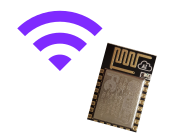
Using the ESP8266 with Wifi
This tutorial provides an intro to using Espruino running on the ESP8266 over Wifi instead of hooked up via the serial port.
Wifi Configuration
The first step is to configure Wifi to maintain a persistent connection. You need Wifi to be stable even when you reset the ESP8266, when your code doesn't run, when you upload bad code, etc. The way you do this is to connect to your access point and then save the wifi config. After that, do not try to connect in your code: it will happen automatically.
There are 3 steps to getting started. As you follow along, you may want to consult the Wifi library reference.
1. Connect to your access point
var wifi = require("Wifi");
wifi.connect("my-ssid", {password:"my-pwd"}, function(err){
console.log("connected? err=", err, "info=", wifi.getIP());
});
wifi.stopAP();
You should see a message saying "connected? err= null" message after a few seconds and your ESP8266 will be on the network! If an error is shown, adjust your connect call appropriately.
1-alt. Create an access point
Using the ESP8266 is not recommended in general because its functionality is very limited and you'll have to reconnect to the AP whenever something bad happens, but it's a handy mode if you're out on the road and don't have an AP you can use to get internet access. To get that going use:
var wifi = require("Wifi");
wifi.disconnect();
wifi.startAP("my-ssid", {password:"my-password",authMode:"wpa_wpa2"});
You should see the access point appear on your phone or laptop if you do a wifi scan.
You can verify the ESP8266's IP address using wifi.getAPIP(), it should be 192.168.4.1.
2. Connect via the web IDE
Start the Espruino Web IDE, open the settings (gear icon), and on the communications tab set the
IP address and port of your ESP8266, e.g. something like 192.168.1.34:23 or, if you're using
the AP mode it would be 192.168.4.1:23. Note the :23, which is the port on which
Espruino is listening.
Close the settings and hit the connect button (yellow disconnected plug icon) and choose
your TCP entry. You should now be connected to your ESP8266's interpreter. You can type
wifi.getStatus() to confirm. To get a clear interpreter environment, type reset().
If you do not want to use the IDE, you can also connect using a simple terminal program. Just use the ESP8266's hostname or IP address and port 23.
3. Name and persist
You probably want to assign a DNS name to your ESP8266 so you don't need to chase the IP address, the ticket for that is:
wifi.setHostname("my-esp");
Finally, you need to save the settings so they persist across hard-resets and power cycles:
wifi.save();
At this point you can power cycle your ESP8266 and then reconnect from the IDE (you may have to manually disconnect first, the IDE is slow at detecting that the connection got cut). Note that the saving of the wifi settings means that your program code should not configure the wifi unless you want special effects that cannot be achieved simply by saving your current wifi config.
Troubleshooting
Recovering from saved JS code
Sometimes you may have commands stored in the regular JS save area that mess with wifi at
start-up, or some other weird stuff is happening. To recover, try this: reset() to clear
the interpreter. Then save() to clear the JS save area. Then use the wifi commands to
connect to you access point and otherwise get the wifi into the state you want. Then
use wifi.save() to save the wifi settings and power cycle or reboot your esp8266
(require("ESP8266").reboot() will work too). Now ensure that it comes back up the way
you want. Then load your application JS code (without any commands that mess with wifi
in it) and use save() to commit that to flash. Now reboot again and the esp8266 should connect
to wifi and run your code.
Recovering from an endless reset loop
This is not all that related to wifi, but... Sometimes you may have saved JS code that causes Espruino to crash or otherwise mess things up such that you can't gain control over the interpreter. The solution is to flash over the JS save area: flash blank.bin to 0x7a000 (or consult the current flash map and pick the last 4KB sector of the save area).
If you need to wipe the wifi save area flash blank.bin to 0x7b000.
How to wait for a connection before starting services
You can actually start any listening sockets at any time, even before a wifi connetion is established. The listening socket is on the wifi interface devices and doesn't care whether wifi is connected or not, whether the IP address changes over time, etc.
If you need to make outbound calls, the recommended approach is to retry until successful instead of waiting for a connection because that is a more robust approach which can deal with errors other than just the loss of wifi association.
This page is auto-generated from GitHub. If you see any mistakes or have suggestions, please let us know.